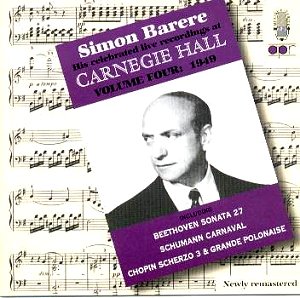Volume Four of APR’s Barere series takes us to two
live Carnegie Hall recitals in February 1949. Bryan Crimp in his notes
speculates that the Beethoven Op 90 might in fact derive from a recital
Barere gave in November 1947 – there seems some doubt regarding documentation
though the discs themselves are labelled February 1949. As ever the
recordings derive from the collection of the pianist’s son Boris, himself
a musician of note. Boris Barere managed to record his father’s recitals
from the vantage of a studio above the stage of Carnegie Hall. In his
last recording, recently issued on the Cembal d’Amour label and reviewed
here, Simon Barere’s admixture of virtuosity and poetry was held in
admirable balance. Stunning feats of bravura, for which he was of course
renowned, co-existed with moments of exceptionally acute poetic illumination.
In recital though Barere could push things to extremes and there are
moments here in these live readings in which stupendous digital feats
are juxtaposed with more troubling features.
Chopin’s Andante Spianato and Grande Polonaise brillante
is certainly fluent, to say the least, the Polonaise vivid,
outsize-dramatic, with brilliant passagework and some incendiary pianism
– but the conclusion is rather gabbled. His Beethoven sonata – of 1947
or 49 or whenever – is rather attractive; it has a heartfelt nobility
with a slow movement of really splendid line, the bass pointing of exquisite
depth. The central panel of the disc is Carnaval, a reading of ups and
downs. The Préambule begins poorly, perhaps somewhat nervously,
with a succession of wrong notes and a decidedly unstable and uncomfortable
tempo. Pierrot is insistent, Arlequin stormy, Florestan
full of dramatic contrast and fierceness, Sphinxes incandescently
saturnine, Papillons hammered out viciously – see Myra Hess for
the opposite approach – Chopin quite beautiful (poetic, softened
dynamics, acutely understanding), Valse allemande full of attractive
rhythm but very pronounced and acerbically violent, Paganini shot
through with leonine grandeur and the Davidsbündler thunderous
and overdriven. Most exciting to hear if not necessarily to live with.
The Chopin group is intriguing if inconsistent. His C sharp minor Waltz
is powerfully arresting but the A flat Waltz is, well, just fingers
(as Horowitz dismissively said of Levitzki). The C sharp minor Etude
is abrupt and almost uncontrolled, dropping notes worryingly and we
get an encore of the G flat major Etude to delighted applause, albeit
the New York audience does suffer the effects of a plainly arctic winter;
as well as the private nature of the recordings you will have to submit
to some coughs and splutters.
My views on Barere are plainly mixed and live Barere
only serves to magnify them. The latest volume of the series has typically
splendid documentation and has extracted optimum sound quality from
these live performances. There’s no doubt that Barere was a stunning
pianist – I just wish sometimes he had been as consistently stunning
a musician.
Jonathan Woolf
